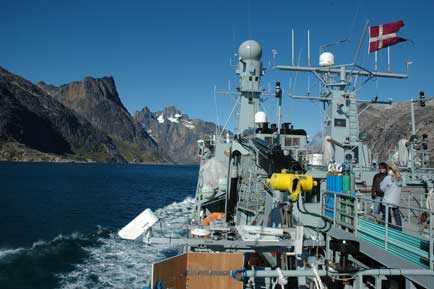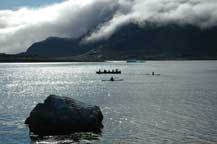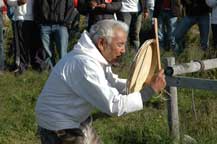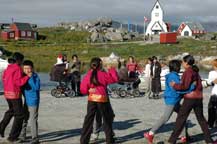From the Faeroes to Greenland Newsletter 2
Dato 25.8.2006
Newsletter 2
18 – 23 August 2006
25 August 2006
VÆDDEREN had enjoyed a successful if curtailed stopover in Torshavn. She sailed westwards at full steam, the weather still fair. One trawl net had been lost on a night operation at the Faeroes, which was of course annoying. This is the sort of thing that happens and must be watched out for in future.
Fulmar, kittiwake (a kind of gull) and gannet flew alongside and a single yellow wagtail landed on the quarterdeck to rest before continuing on his way to some destination unknown to us. By midday we sighted whales.
One of the evening activities on board VÆDDEREN is lectures in the hangar. Researchers talk about their particular projects to an audience of scientists and crew members. At night, water samples are gathered, after which analysis in the labs continues till the next morning.
The CTD (Conductivity-Temperature-Depth/Pressure) profiler - which gathers samples- is in use around the clock. The projects which rely on this workhorse of a machine are the Roseobacter project, Dissolved Organic Matter, the DNA of the Polar Sea and the Marine Carbon Cycle.

Photograph Morten Meldgaard, the Danish Expedition Foundation
All the Galathea 3 projects are presented to crew, media and fellow scientists. The presentations take place in the helicopter hangar, usually in the evening.
Saturday 19 August, 2006 - Galathea 3’s working day
Extract from the diary of Danish Expedition Foundation’s director, Morten Meldgaard.
This morning at 6.30 I went down to the researcher’s quarters to see if there was any movement. I met the Blom brothers, engaged in filtering. Between 04.00 and 06.00 hours they had successfully cast the CTD profiler to 2,000 meters and collected a couple of hundred litres from the Iceland Basin for the DNA project. They were happy that their first sampling exercise had gone well. But it was clear that they had several hours’ filtering work to do before they could repair to their bunks.
The Blom brothers reported that the CTD cast had been conducted by other projects at this depth, with the Carbon Cycle, Dissolved Organic Matter and Roseobacter researchers investigating. Their cast had taken considerably longer - around four hours - as they collect samples during the entire cast, i.e., at several depths. Moreover, there had been some nervous moments when data transmission had been interrupted, perhaps because the high pressure had forced some unwanted water in.

Photograph Morten Meldgaard, the Danish Expedition Foundation
Planning meeting for researchers with Minik Rosing, section leader, on the far right.
The planning meeting was held as usual at 07.30 hours. It was agreed that we would set up a whiteboard in the hangar which would show the day’s research projects. This would make it easier for everyone to see what is going on. The meeting discussed the stages up until Nanortalik, including priorities of projects and stations. Ideas were then presented to the ship’s meeting, which was moved from its usual slot at 8.30 to 13.00 because most people had gone to bed at 05.00. Today it seems we shall be sailing west for much of the day. The operations officer works out the precise itinerary based on the meetings and in consultation with the ship’s command. He will be able to say whether the researcher’s plans tie in with the ship's running capabilities or whether some adjustments may have to be made. As things look now – and if the weather holds and Prince Christian Sound is open – we can carry out our research and be back on track in Greenland in good time!
(---)
Early this morning we were in the Irming Sea, where some major currents meet and where we shall investigate by means of a CTD cast, the Triaxus (a tow ‘fish’ or vehicle, equipped with electronic sensors which is used for gathering oceanographic data), and plankton and trawl nets. It’s going to be a very exciting, full day".
Whaling safari, church service and a double birthday.
Sunday 20th August 2006. Calm, light swell, overcast. Perfect weather for research…. The ship reached its destination around 07.30 hours: the deepest part of the Irming Sea, roughly midway between Iceland and East Greenland.
The CTD profiler was again at work – this time diving to 2,800 metres. This was followed by another plankton trawl, and a further CTD cast. All morning a large pod of pilot whales – more than 100 -were foraging near the ship. Suddenly the man overboard alarm sounded. This was only an exercise, but crew reaction time was nonetheless important. Within barely five minutes the lifebuoy ‘in distress’ was revived in the infirmary…. Media teams were allowed an opportunity to use the rescue boat for a closer look at the whales.
At 13.00 hours a mass was held.
By 16.00 hours water sample and plankton collection from the Irming Sea was complete, and the ship continued on her course towards the East Greenland Current.
Normally there is no drinking of alcohol on board VÆDDEREN, but the Captain may decide to dispense with this rule on certain occasions. Two people had birthdays on Sunday, which occasioned two glasses of red wine per person to accompany the roast beef…....
Night brought with it the usual collecting of samples in the dark, mist and cold, followed by analysis.
Growler on the port beam
Monday 21 August was marked by uncertainty as to whether the expedition would be able to sail through Prince Christian Sound, the narrows running west from the south eastern tip of Greenland. A growler, or small floe of about 250 metres across seemed to be blocking our way – which could mean that we would have to go round Cape Farewell. We had news that the container ship Mary Arctica was going to attempt to sail through during the day, so VÆDDEREN waited for news – and hoped for the best.
Morten Meldgaard’s diary entry from 21 August 2006: “At 1 o’clock the cold mist that had been enveloping both the sea and us suddenly cleared. The sun illuminated the East Greenland coast in all its glory. White-sided dolphins sprang gracefully from the water, sei whales caught krill and ice fields were mirrored by the still sea. Then we heard that the Mary Arctica had passed through the Sound, and it was decided that later we would follow suit.
There was time for a four hour trawl for marine organisms from 0 to 800 metres’ depth. Whilst the trawl was underway the lecture programme continued with a 4 o’clock lecture by Jan Christensen of NERI (the Danish National Environmental Research Institute) who is part of the Foreign Elements project. It was excellent and awakened a lot of interest. (...)
The next show was at 20.00 hours: “Palos Brudefærd” (The Wedding of Palo) made in South East Greenland in 1933 by Knud Rasmussen. One of the crew members, who knows a great deal of the history of research in South East Greenland and Naja Mikkelsen gave us an introduction to the film. It was great.
But just before the film’s dramatic ending everyone was called up to see the results of Jens Tang Christensens’ trawl. It was full of the weirdest creatures from the depths. Fish with huge mouths, fish with amazing light organs, deep sea shrimp, krill and many other curiosities. A rewarding catch”.
A warm welcome, aged seal meat, traditional drum dancing and hymn singing.. 22 August 2006: “07.00 hours. Approaching Prince Christian Sound under clear calm weather. Sailing through the sound was an unforgettable experience for everyone. We were witnessing a vast mountain backdrop, glaciers which project into the sound and waterfalls sending cascades over naked cliff walls: scenery of unearthly beauty. The community of Augpilatoq lay half way along it, alone in a bend and surrounded by massive rocks. As we gradually approached the west coast, we could see that the rock faces were becoming greener and more fertile- we were closer to the warm sea streams that flow along the coast of West Greenland.

Photograph Morten Meldgaard, the Danish Expedition Foundation
VÆDDEREN negotiating the narrow Prince Christian Sound which connects East and West Greenland.
13.30 hours; we docked at a sunny Nanortalik. It seemed the whole town had turned out to meet us. Canon salvoes, flags, schoolchildren. A festival. Mayoress Kristine Råhauge gave a welcome speech on the quayside. From 15.00 to 19.00 hours there was a wonderful programme for everyone created by museum director Sørine Gejl and local tourism officials. It started with tastings of dried fish, smoked musk-ox, caribou, lamb and dried whale meat and included the singular Nanortalik speciality: fermented seal meat and oil.

Photograph Morten Meldgaard, the Danish Expedition Foundation
A warm welcome in Nanortalik. Tasting culinary specialities such as fermented seal meat, dried whale meat, smoked musk-ox and more besides….
First the exhibition “Settlers from the East” was opened. This is about the immigrants from East Greenland and had arisen in association with the climate and environment project and the National Museum’s collaboration with Nanortalik Museum. The Mayoress gave a fine speech and Captain Carsten Schmidt presented some drawings of VÆDDEREN to a local builder of ship models.
There followed a tour of the town, ending in the old port settlement, where the museum has mounted several exhibitions and reconstructed tents and winter houses. In this lovely museum setting, we saw shows of the ‘woman’s boat’ (umiaq), kayaks and drum music with song. We were then taken to an open space where children in costume from the “Qakku qiimasut” group performed Greenlandic folk dance. From there, we went to the church and heard the local choir, “Nipaasa”, part-singing some wonderful hymns and songs.
 
 
Photograph Morten Meldgaard, the Danish Expedition Foundation
Kayak and umiaq trips, drum dance, children’s folk dance and hymn-singing in the town church. In short, all the stops were pulled out for Galathea 3's visit to South Greenland.
In the evening Galathea members addressed a full house: their talk about the expedition and the research work around Greenland, translated by an interpreter, was received with good cheer.
Everyone, including crew members, researchers and media were happy: they had found a welcome rest after the intense period following the departure from Copenhagen via the Faeroes to South Greenland”.
That same day news arrived from the researchers on one of the land-based Galathea-3 projects in South Greenland, the Ikka project. Some exciting discoveries had already been made.
Wellbeing and warm springs
On Wednesday morning VÆDDEREN left Nanortalik heading in the first instance for Unartoq . A few hours' time out were granted: the perfect opportunity for a dip in the warm springs, with their view over the fjord and the ice fields. The springs have been used as warm baths since the time of Norsemen.
Then on to a trawl for shellfish, crab etc destined for the Environmental Pollution project. This went very well except for a shortage of clams, so the expedition headed for some promising banks towards the north.
Minik Rosing delivered a lecture on the Earth’s formation in the evening. As mentioned before, he is expedition leader for the stretch to the Azores, his main occupation being director of Copenhagen’s Geological Museum. He became famous for his discovery of evidence of living organisms in carbon, dating from 3.8 billion years ago, in a stone 150 km north of Nuuk. It was a sensational find which placed the first known life-forms about 300 million years earlier than previously thought.
Follow Galathea 3 at Google Earth and see the week’s satellite pictures at www.satelliteeye.dk/index_uk.htm.
|